

 | ||
 | ||
Vol. 12 (1): June 2009 | ||
Freedom at last for KP2The first successfully released hand-reared Hawaiian monk sealDavid Schofield, M.Sc.Interim Hawaiian Monk Seal Recovery Coordinator |
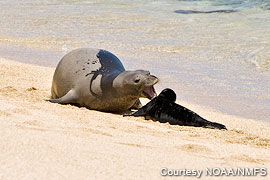 | |
| KP2 is rejected by his mother. | |
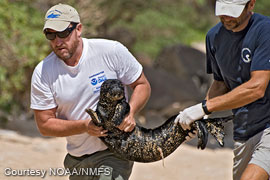 | |
| The infant seal is rescued by NOAA staff. | |
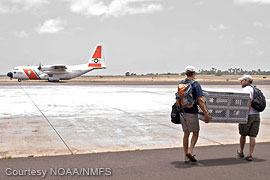 | |
| The US Coast Guard airlifts the seal aboard a C-130 to Honolulu. | |
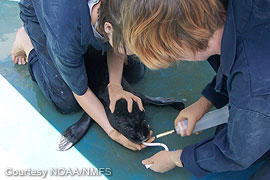 | |
| KP2 being nourished on formula at Kewalo. |
A male Hawaiian monk seal temporarily identified as “KP2” was first observed on May 1, 2008 on a Kauai beach after apparently being abandoned by a young female seal. This particular young female seal had abandoned her pup the previous year soon after pupping, and that pup died. On May 2, attempts were made to reunite the pup with his mother. The attempts were unsuccessful, so the decision was made to collect the pup with the goal of captive rearing it. The United States Coast Guard airlifted the seal aboard a C-130 to the National Marine Fisheries Service (NMFS), Kewalo Research Facility, Honolulu, Hawaii under National Oceanic Atmospheric Administration/National Marine Fisheries Service (NOAA/NMFS) Marine Mammal Health and Stranding Response permit # 932-1489-09. This was a joint effort between the NOAA/NMFS Pacific Islands Fisheries Science Center (PIFSC) and Regional Office (PIRO).
The pup, approximately 24 hours old at capture, weighed 15.7 kg and appeared dehydrated upon admittance into rehabilitation. His umbilical wound appeared inflamed and was cleaned with a dilute iodine solution. Broad-spectrum antibiotics were given orally for 10 days to minimize risk of infection via the umbilicus (a common cause of mortality for hand-reared neonatal harbor seals). Subcutaneous and oral fluids were administered for rehydration.
The Marine Mammal Center (TMMC) of the Marin Headlands of Sausalito, California was contacted immediately to take on the immense task of hand rearing this neonate. Since 1975, over 12,000 animals, such as elephant seals, sea lions, sea otters, harbor seals, fur seals, dolphins, harbor porpoises and the like, have been rescued and treated at the hospital facilities of TMMC. TMMC recognizes human interdependence with marine mammals and their importance as sentinels of the ocean environment, the health of which is essential for all life. TMMC recently partnered with NMFS because of their desire to provide expertise in Hawaiian monk seal recovery through science based projects. As a result, under the direction of pinniped veterinarian Dr. Frances Gulland, TMMC provided veterinary consultation and sent shifts of experienced volunteers and staff to Honolulu to direct the daily feeding, care and husbandry for the 227 days that KP2 spent in rehabilitation. Oahu based volunteer monk seal responders also assisted in the latter part of KP2’s care with nighttime observations.
KP2 gained about 52kgs over his 7.5 months under human care. “Initially, the biggest challenge was finding the right nutrition for the seal when it was being fed formula [a mother’s milk substitute developed for pre-weaned seals and other marine mammals in captive care, including fish, salmon oil, and fatty milk products]. Later, the challenge was to get KP2 to learn to eat on his own,” stated Dr. Gregg Levine, NMFS contract veterinarian in charge of the medical oversight of KP2. Levine and teams of TMMC and NMFS volunteers used previously established techniques for elephant and harbor seals to help KP2 transition to eat live moi, a local bait fish that Hawaiian monk seals are known to consume.
Medical concerns shifted from nutrition to a swollen muzzle that appeared on July 9, 2008. The swelling was thought to be related to an insect sting. KP2 was placed back on oral antibiotics and the condition appeared to resolve quickly.
By late July 2008 discussions regarding release were initiated. However, on August 4, 2008 mild diffuse bilateral corneal edema was noted. Discussions on release were halted and a thorough diagnostic evaluation was done to determine the cause of the ocular disease. Empirical drug therapy for common causes of corneal edema were attempted in logical order, with effects of treatment carefully monitored. The corneal edema rapidly progressed in severity and by the end of August both eyes had moderate to severe corneal edema.
The thorough diagnostic work up evaluated eye swabs and blood serum for infectious diseases. All tests for pathogens were negative. It was hypothesized that the corneal edema could be due to a combination of environmental factors in KP2’s enclosure (i.e. bright reflected sunlight and water quality issues). The decision was made to attempt to mitigate the potential environmental factors and move KP2 to ocean water in a shoreline pen on a protected beach on the island of Oahu to see if the eyes would improve in this new environment.
On September 8, 2008, KP2 was moved from the Kewalo Basin Research Facility to a shoreline pen at Marine Corps Base Hawaii in Kaneohe Bay. Seawater in his shoreline pen ranged from 1 to 3.5 feet in depth depending on tides. KP2 acclimated quickly to his new environment. Over the next two months his ocular condition improved and he was observed tracking, catching and consuming live fish and crabs that entered his pen in addition to his daily ration of dead herring. KP2 was observed pushing rocks into one corner of the beach pen that was usually under water. During the day, he would spend a lot of time hunting and foraging near this “artificial reef” for small fish and sea cucumbers that came there for refuge in the rock pile. A local Marine Corps enforcement officer would routinely collect live tako (Hawaiian for octopus) weighing 1.0 to 4.0 kg for KP2. In addition to the hours of “pre-release” exposure to a prey item often consumed by Hawaiian monk seals, the tako provided environmental enrichment and supplemental nutrition.
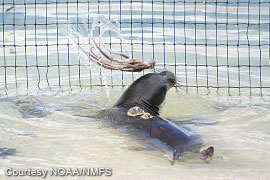 | |
| Live octopus was provided during the latter stages of rehabiliation. |
As KP2’s eye condition improved it became evident that he was ready for reintroduction to the wild. Due to the critical condition of the Hawaiian monk seal population, NMFS wanted to ensure that this seal posed no threat to the wild population and adhered to the criteria all marine mammal releases must comply with in the NOAA/NMFS Marine Mammal Health and Stranding Response Marine Mammal Release Guidelines. To ensure his eye condition was not related to an infectious process, additional tests including ocular ultrasound were undertaken and the results were examined by many agencies and external experts. KP2 was cleared for release by the NMFS Office of Protected Resources. Again with the help of the United States Coast Guard, KP2 was transported on December 16, 2008 aboard a HH65 helicopter to a remote area on the island of Molokai. The release site was selected primarily because it is used regularly by other seals and would provide the opportunity for KP2 to socialize. An additional consideration was that there are few people in the area, which would reduce the likelihood of KP2 interacting with humans after his habituation and subsequent conditioning to human care givers. Prior to release KP2 was instrumented with a small satellite linked time-depth recorder and a VHF tag. Both tags were affixed to his pelage with epoxy.
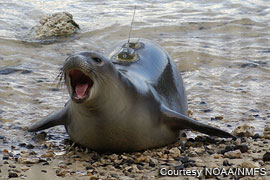 | |
| KP2 ready for release, equipped with a satellite linked time-depth recorder and a VHF tag. |
At the time of this writing KP2 is doing well. One concern was whether or not a naïve seal would be able to adapt and develop normal dive behavior upon release. “So far KP2 has been behaving like other young seals we have studied,” said Dr. Charles Littnan, PIFSC Monk Seal Research Program Leader. “He has slowly been venturing further from the release site and diving deeper as he gains experience.” He has been in the wild since 16 December and has been observed feeding and interacting with another young male monk seal. In January he traveled over 65 km from his release site and successfully found his way back on Molokai. In addition, he traveled one day to Lanai. All signs currently point to a successful reintroduction to the wild. However, if he shows signs of failing to thrive plans are in place to recapture KP2 and put him permanently into a facility for captive research and public display. Should the seal continue to do well, he will be captured in 3 month intervals over the next year for medical examinations, both to ensure he is healthy and to gather baseline information for future cases.
The capacity to rescue pre-weaned pups, care for them in captivity and release them back to the wild population is a high priority and will contribute to the recovery of the Hawaiian monk seal. The Recovery Plan for the Hawaiian Monk Seal, the Hawaiian Monk Seal Recovery Team, TMMC and NOAA/NMFS share the view that every seal should be considered vital to the population and to the recovery potential of this species. During this experience we have learned invaluable lessons about caring for pre-weaned pups that will contribute to the adaptive management approach integral to future monk seal recovery efforts.
Over the past four years management actions and research in the MHI have provided valuable insights on how to deal with pups born on popular beaches, our ability to relocate seals within the main Hawaiian Islands and evaluate the threats of exotic diseases etc. Future rescues will likely involve cases where interactions with people or domestic animals have caused the abandonment of a pup. In the future NOAA/NMFS and its partners will continue to focus on critical recovery actions, with the ultimate goal of salvaging reproductive potential and recovering the Hawaiian monk seal.
NMFS Pacific Islands Region would like to thank the following people and organizations for their contributions of expertise, resources, and associated expenses that resulted in the success of this project.
The Marine Mammal Center for medical advice, daily feeding and husbandry of KP2:
Staff: Dr. Frances Gulland, Tenaya Norris, Deb Wickham.
Volunteers: Emily Andrews, Stephanie Behasa, Kat Rudd, Michelle and Keith Blascow, Misuzu Toyama, Sarah Codde, Marie DeStefanis, Stan Jensen, Rebecca Ryan, Suzanne Canja and Aubrey St.Marie.
The Hawaiian Monk Seal Response Team Oahu:
Volunteers: Donna Festa, Karen Bryan, Barbara and Robert Billand, Brenda Sparks, DB Dunlap Jim and Kathy Brown, Jessica Ashettino, Karen Rhoter, Kelly Blanchard, Chris Blanchard, John and Lisa Johnson, Dana Jones, Sharon Cosma, Jennifer and Rafe Maldonado, Darin Padula, Liv Wheeler, Barbara and Ralph Allen.
Agency support for transports and seal holding: United States Coast Guard, Air Station Barbers Point and the United States Marine Corps Base Hawaii.
Copyright © 2009 David Schofield, The Monachus Guardian. All Rights Reserved |